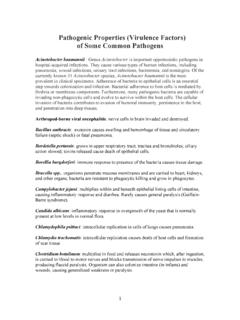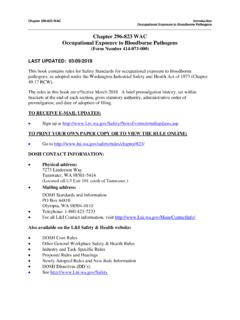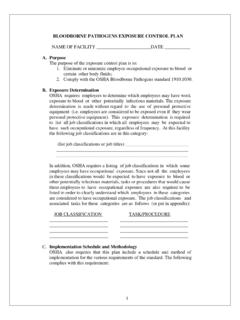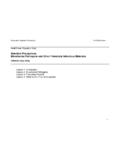Transcription of Bloodborne Pathogen Training
1 Bloodborne Pathogen Training It's important that you understand the provided Training . If at any point in this presentation you have a question STOP and contact your employee health department or your area infection control department. Goals of Training : Knowledge of regulatory requirements Increase awareness of diseases Provide information regarding: Routes of exposure Risk of transmission Prevention Regulated Requirements OSHA Bloodborne pathogens standard Designed to protect workers In effect since 1992. Goal: Prevent occupational transmission of diseases potentially present in blood and bodily fluids Bloodborne pathogens Bloodborne pathogens are microorganisms that can cause disease when transmitted from an infected individual to another individual through blood and certain body fluids. Bloodborne pathogens are capable of causing serious illness and death. The most common illnesses caused by Bloodborne pathogens are hepatitis B (HBV), hepatitis C (HCV), and acquired immunodeficiency syndrome (AIDS).
2 From HIV, or humanimmunodeficiency virus. Body Fluids That Can Transmit Infection Blood Semen Vaginal secretions Cerebrospinal fluid Synovial fluid Pleural fluid Pericardial fluid Peritoneal fluid Amniotic fluid Saliva ( dental procedures). Any unfixed human tissue or organ Methods of Transmission of Bloodborne pathogens (BBP). Transmission of Bloodborne pathogens can occur in a variety of methods. The most common mode of transmission to Health Care Workers (HCWs) is a sharps injury from a contaminated item (scalpel blade, needle, surgical instruments, etc). Transmission can also occur if a BBP comes in contact with mucous membranes of the HCW. This can result from a splash to the eyes, nose, or mouth. Contact of blood or OPIM with non-intact skin also has been associated with transmission of BBP's to HCWs. Standard Precautions Standard Precautions are required by law to be practiced by all Health Care Workers. This means that all blood and body fluids must treated as if they can transmit Bloodborne pathogens to the caregiver.
3 Standard Precautions are designed to reduce the risk of transmission of pathogenic microorganisms from both recognized and unrecognized sources of infection in the health care setting. Using Standard Precautions means you must take steps to protect yourself and others from the risks associated with BBPs. PREVENTION: Universal precautions Treat all blood and other potentially infectious body fluids as if infected Avoid direct contact with blood and body fluids &. contaminated materials Wear PPE appropriate for job Practice good housekeeping and personal hygiene Follow proper decontamination procedures Dispose of all contaminated materials properly Seek prompt medical attention in the event of exposure Risk Of Infection From Occupational Exposure Overall risk depends on: # infected individuals in patient population Type and # of blood/fluid contacts Risk factors following exposure: Pathogen involved Type of exposure Amount of blood/fluid involved Amount of virus present in blood/fluid at exposure Hepatitis B.
4 Hepatitis B is a liver disease caused by the hepatitis B virus (HBV). Hepatitis B, formerly called serum hepatitis, is a life-threatening Bloodborne Pathogen and a major risk to employees in jobs where there is exposure to blood and other potentially infectious material (OPIM). Hepatitis, which means inflammation of the liver, can be caused by drugs, toxins, autoimmune disease, and infectious agents, including viruses. HBV Vaccination HBV vaccination series will be made available to employees at risk of exposure at no cost. Employee may decline series by completing declination form. If employee declines series, may elect to have series at a later time. Hepatitis C. Hepatitis C is a liver disease caused by the hepatitis C virus (HCV). It is the most common chronic Bloodborne infection in the United States and is primarily transmitted through large or repeated direct percutaneous exposures to blood. Most people who are chronically infected are not aware of their infection because they are not clinically ill.
5 Infected people can infect others and are at risk for chronic liver disease or other HCV-related chronic diseases. Currently there is no vaccine against hepatitis C. Human Immunodeficiency Virus (HIV). HIV infection has been reported following occupational exposures to HIV-infected blood through needlesticks or cuts; splashes in the eyes, nose, or mouth; and skin contact. Most often, however, infection occurs from needlestick injury or cuts. Currently, no vaccine currently exists to prevent HIV. infection, and no treatment exists to cure it. Potential Hazard HIV. Exposure to potentially fatal Bloodborne illnesses such as Human Immunodeficiency Virus (HIV). Risk of HIV infection after needlestick is 1 in 3,000 or The CDC documented 57 cases of occupational HIV transmission to healthcare workers between 1985 and 2001 in the United States, and no confirmed cases have been reported since 1999. Occupations Covered By The Standard The hazard of exposure to infectious materials affects employees in many types of jobs.
6 The following occupations are likely to be covered by the standard, but the scope of the standard is not limited to employees in these occupations: Occupations Covered By The Standard? (continued). Physicians, physician assistants, nurses, nurse practitioners, and health care employees in clinics and physicians' offices Employees of clinical and diagnostic laboratories Housekeepers in health care facilities Workers in hospital laundries or commercial laundries that serve health care or public safety institutions Occupations Covered By The Standard? (continued). Tissue bank personnel Employees of blood banks and plasma centers who collect, transport, and test blood Employees of freestanding clinics such as hemodialysis clinics, urgent-care clinics, health maintenance clinics, and family-planning clinics Employees of clinics in industrial, education, and correctional facilities ( , those who collect blood and clean and dress wounds).
7 Occupations Covered By The Standard? (continued). Employees assigned to provide emergency first aid Dentists, dental hygienists, dental assistants, and dental laboratory technicians Employees of institutions for the developmentally disabled Hospice employees Home health care workers Occupations Covered By The Standard? (continued). Employees of nursing homes and long-term care facilities Employees of funeral homes and mortuaries HIV and HBV research laboratory and production-facility workers Employees handling regulated waste Emergency medical technicians, paramedics, and other emergency medical service providers Personal Protective Equipment (PPE). Personal Protective Equipment (PPE) may be required based on the activity being performed. Examples of PPE include: gloves, gowns, aprons, face shields, masks, resuscitation mouth pieces, and ambu bags. It is essential that PPE be worn when appropriate and also that it is removed and disposed of correctly.
8 This means it must not contaminate you or the environment. Special PPE Precautions Cover open cuts, rashes, and other broken skin. Check condition before using Remove carefully to avoid contaminating yourself or anything around you Dispose properly Don't mix contaminated clothing or laundry with other laundry Wash hands thoroughly after removing gloves. Gloves Gloves are the most frequently used type of PPE. They provide a barrier between your hands and infectious material. Latex-free exam gloves and surgical gloves are used for medical, dental, and laboratory procedures. Heavy duty utility gloves should be used for housekeeping activities and for laundry workers handling soiled linen. Gloves should be examined for integrity (holes and tears). before using them. Disposable gloves are intended for single patient use only and you should not attempt to clean or decontaminate them. Gowns Gowns are worn to protect skin and prevent soiling of clothing during procedures where splashes or sprays of blood or OPIM are anticipated.
9 Contaminated gowns or clothing should be removed as soon as possible to prevent employee exposure. Contaminated apparel from work areas where exposure to blood or OPMI occurs should not be worn outside of that area. Scrub suits are not considered PPE since they offer minimal or no resistance to fluid penetration Masks and Eye Protection Masks and Eye protection must be worn to protect mucous membranes during patient care activities when splashes or sprays are anticipated. Prescription eyeglasses are not considered adequate protection because they do not protect from the potential for exposure through open areas at the top and side of the eyewear. Engineering Controls Engineering Controls are physical or mechanical systems used to eliminate hazards at their source and prevent staff exposures. Engineering controls include (but are not limited too) the following: Hand Antisepsis facilities must be available at or near the point of care Sharps containers are properly located and at the proper height Sharp safety devices are used and Training on their use is provided Biohazard waste bags are located in patient care areas Work Practice Controls Work Practice Controls are specific procedures or policies that must be followed to reduce your risk of exposure to blood or OPIM.
10 Examples of work practice controls include: Hand hygiene policy which provides specific guidance on when and how to perform hand hygiene Place sharps in sharps containers immediately after use Do not bend or recap needles No eating or drinking in patient care areas Use leak proof specimen containers Proper segregation of trash Housekeeping Housekeeping, good housekeeping protects health care workers and is every workers responsibility. Disinfectant wipes are available for use in clinical areas to disinfect hard surfaces counters, exam tables, computer keyboards, stethoscopes. Gloves must be worn when handling environmental wipes Each work area must be cleaned at least once per shift Place sharps and infectious waste in designated containers Decontaminate equipment before sending it for repair Handle laundry as little as possible and carry it away from your body Clean equipment and surfaces as soon as possible after contact with blood or OPIM.







